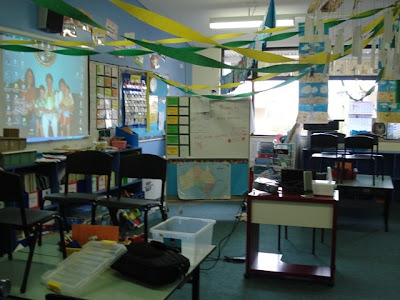Unfortunately the text within our video presentation did not come out too well, so here it is:
STRUCTURE
Starting Top Left – Anti clockwise
-Energy efficient, 2-stage HVAC system reduces energy consumption and uses R410A refrigerants that to not harm the ozone layer
-Solar panels, back energy for lighting
-High efficiency fluorescent lighting, mean which occupancy sensors conserve energy by turning lights off when people come and go; lights off when people come and go; lights are dimmed when natural light reaches proper levels
-Recycled content carpet tiles help reduce landfill waste.
-Formaldehyde-free, low VOC paints and coatings reduce “off gassing’ that can result in dangerous pollution
-100% recycled plastic water tanks
Eco-friendly Interior wall finishes include recycled cork & super insulated kingspan panels for fixed walls
MATERIALITY & SYSTEMS
Starting Top Left – Anti clockwise
-White roofing(instead of black) reflects solar heat and reduces air conditioning loads to save energy
-Double insulated low ‘E’ glazing in thermally broken aluminium extruding framing system
Openable glass vent
-Recycled steel construction produces a structure that is strong, non-combustible and mold resistant because its cellulose-free (67& recycled content)
-Environmentally & ozone friendly Icyene, a water based, sprayed floor insulation & rigid Polyis, made with recycled materials, provide a continuous blanket around the exterior walls and roof for superior thermal protection, energy saving & mold resistance
-Eco-friendly exterior walls finishes include super insulated kingspan panels for fixed walls & 100% recycled plywood sheeting used in their entirety, to minimise waste, the use of which slows deforestation and helps preserve natural habitats
DETAIL
Top to bottom
-Carpet with recycled fibres
-Plantation plywood
-Felt
-Steel track
-Sprayed in place Ilcynene foam insulation
-Large windows that measure along the side of the structure provide increase window to wall ration for better exterior viewing by the occupants and reduces the need for artificial lighting.
-Manoeuvrable panels on the exterior help regulate direct sunlight penetration. Steel roller tacks allow panels to be manoeuvrable. Furthermore our post and beam construction means that all of the interior and exterior walls can be moved or renovated easily because they are not load bearing.
-Steel roller track securely fastened to plywood panel
RARE Architecture
Renewable
-Use of recycled materials
-Implementation of sustainable systems
-Environmental
-Use of efficient HVAC system
-Water collection
-Use of solar panels
Relocatable
-Flexible, modular construction system comprising of recycled steel portal frame & prefabricated panels
Adaptive
-Sliding panels gives the user control of natural lighting & views
-Panel sliding externally creates a unique outdoor learning space

 The drawing above is a development from the bubble diagram. Here we began thinking of the car parking solution, building orientation and their relationships with each other. It took us a while to work out the parking solution as it is already a major problem. We included a specific bus zone with its own entry. We also included a teachers/visitor parking and sepearate parent parking and student drop off zone. Connected to the bus area is a separate car park for the fitness centre which will be used by the extended community i.e old folks at the retirement village behind the school. We also included a maintenance road along the back of the school.
The drawing above is a development from the bubble diagram. Here we began thinking of the car parking solution, building orientation and their relationships with each other. It took us a while to work out the parking solution as it is already a major problem. We included a specific bus zone with its own entry. We also included a teachers/visitor parking and sepearate parent parking and student drop off zone. Connected to the bus area is a separate car park for the fitness centre which will be used by the extended community i.e old folks at the retirement village behind the school. We also included a maintenance road along the back of the school.







 A classroom with interstingly shaped tables!
A classroom with interstingly shaped tables!







 The entire model was laser cut where 1mm strawboard was used for the structure and furniture of the model. The fixed panels and roof were constructed from 3mm MDF and the moveable panels were constructed from 3mm plywood.
The entire model was laser cut where 1mm strawboard was used for the structure and furniture of the model. The fixed panels and roof were constructed from 3mm MDF and the moveable panels were constructed from 3mm plywood.


 The image above illustrates the portable classroom with all panels closed. It also shows the peeping windows where students work can be displayed within on the lattice shelf!
The image above illustrates the portable classroom with all panels closed. It also shows the peeping windows where students work can be displayed within on the lattice shelf!  The photo above shows the water tanks and the plywood panels partially open
The photo above shows the water tanks and the plywood panels partially open






 Above is a sketch which integrates the lattice system wrapping around as the skin of the building. Decking was also used to connect the two classrooms together. The deck creates an outdoor learning area between the two classrooms.
Above is a sketch which integrates the lattice system wrapping around as the skin of the building. Decking was also used to connect the two classrooms together. The deck creates an outdoor learning area between the two classrooms.  We decided to integrate the lattice system on the back wall of the portable classroom. The lattice is more of a square shaped shelving system from floor to ceiling height. The top left of the plan indicates a wet area sitting adjacent to the computer/reading area that is separated by a partition.
We decided to integrate the lattice system on the back wall of the portable classroom. The lattice is more of a square shaped shelving system from floor to ceiling height. The top left of the plan indicates a wet area sitting adjacent to the computer/reading area that is separated by a partition.


